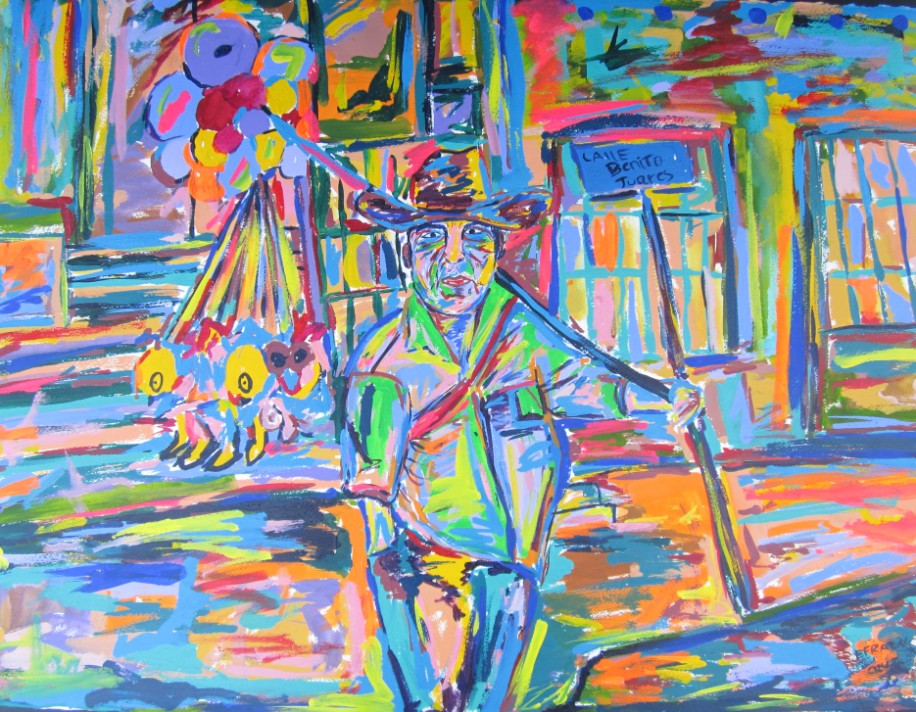Born in Veracruz, México, Efraín Cruz started to explore his artistic side at age five using whichever ‘tools’ he had in sight, in hope that someday he could afford some paint to finish them. Migrating at age thirteen to the US to help his ill mother and save his family from starvation made him not only become an adult while he was still a child, but to also forced him to pause his art-making and get a job in the fields. Cruz shares with us how his life as an immigrant and the struggles that come with it shaped his artistic expression. By now, his work has been on view at The Coca-Cola Collections in Atlanta, The Alabama Museum, Florida International University, Agora Gallery in New York and Wynwood murals in Miami. Later this year, he will be showing his new work at Spectrum Miami during Art Basel week 2016.
Follow Cruz’s interview, where his silence resonates in support of his immigrant culture. The artist chose a written interview as opposed to a spoken one to remind us of how most immigrants have little to no voice.
When did you first experiment with art?
At five years old I started drawing cartoons I saw on TV. I thought that was the way life should look like. I liked that ‘reality’; thought that was how life in America looked like, with all the pretty houses.
After sketching from observation on paper, I would visit the carpenter who lived right beside our house to ask him for some scrap wood. I would heat the tip of a screw in the fire my mother used to cook our meals in and draw with it on the piece of wood. My plan was to save the drawing on the wood until I could afford to buy paint and finish them. In my mind, they needed color, they weren’t finished until I could use paint to finish the work.
Tell us about a mayor turning point in your life that would later impact your artistic practice.
I was thirteen years old when I migrated to the US. I had no plan or idea of what I could expect from doing it, I just knew I needed to do it because I wanted to help my sick mother; she needed money for food and her medical treatment. When you are thirteen years old you are at the mercy of whoever crosses your path. I was obliged to become an adult at thirteen. I went from riding my bike to crossing the border and fearing for my life.It was my idea to migrate to the US. My older brother had already moved to Florida and started working at the fields, so I thought I would join him. There weren’t really any options. Like the old saying says “ Las palabras no entran cuando se tiene hambre”, I really couldn’t focus on school because I was starving. I was underweight and very short for my age. I guess not knowing the dangers of migrating helped my me just go ahead and do it. I saved 600 pesos from my job as a house painter, and without saying goodbye to my family or friends, left. I jumped on a wagon of a cargo train and made it all the way to Florida.
When did you first realize you were an artist?
After working in the field, my brother and I moved to Georgia. We were making some money by then and sending most of it to my mom. My brother asked me, in a challenging way, why I wasn’t painting now that I could afford to buy materials to do so. He told me he knew I was born with this gift. See, in my opinion, artists are born artists. Feeling too much is not always a good thing, you can go from one extreme to another in no time. I was hurting because I wasn’t painting. I got back to painting when I was nineteen and it was hard, it was like starting all over again, but my passion was still there and my wish to give my passion a second chance was reignited.
I was happy to be painting again, although it was sad at times as well since I was painting from my memories from back home. I started getting some attention from people around me that appreciated my work. Art, in many ways, was therapy for me, it helped me cope with my longing to be back home.
Which artists are your main influence?
I admire and feel a certain connection with Rufino Tamayo. He was born in the same town I was born. Diego Rivera made his way and left his artistic mark in the US and for that I admire him. I have so much respect for Pablo Picasso because he never listened to people that tried to discourage his technique and told him he was wrong for doing things the way he was doing them; he established his own style. Being an artist is about breaking boundaries and leaving a legacy behind.
How does the scale of the work impact how you work? You have done small, medium and large works, up to the mural you did in Miami.
Scale doesn’t impact how I work. If I want to convey a feeling or an idea I will do so either on a small piece of paper or on a large canvas. As long as I get the feeling out, that is what matters. I cannot rest until I get it out of my system.
If you had to describe your work using three words, which ones would they be?
Passion, love and perseverance.
Now that you have moved back to México, how has your inspiration been impacted?
I paint what I see in my daily life. It is easier for me to grasp the details of the culture now that I’m living in México but my love for my country has been there all along.
Are you currently producing more work? If so, can you share with us some information on what we can expect?
I am currently producing more work, sculpture work and painting as well for my show in SPECTRUM Miami during Art Basel week 2016. I don’t like to plan things out when it comes to art. I trust the process of life and let time decide. What is meant to come out from my artistic expression, will come out. I like surprises, I like to surprise myself and the audience.


